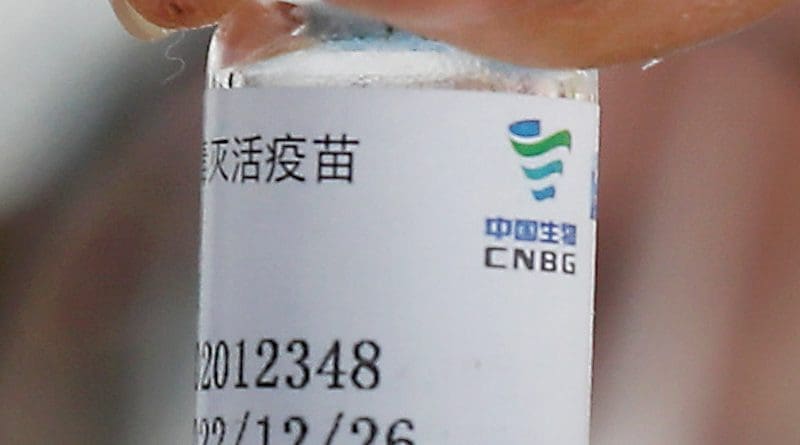China’s Health Silk Road In The Middle East – Analysis
By Passant Mamdouh Ridwan*
The introduction of the Health Silk Road (HSR) and Digital Silk Road (DSR) in 2015 as part of the Belt and Road Initiative (BRI) shows the expansion of China’s diplomacy from infrastructure and construction into the health and technology sectors. Multiple areas of cooperation increase China’s leverage and promote the longevity of the BRI framework beyond the COVID-19 pandemic.
The HSR is an extension of China’s long history of medical assistance in various regions. Africa–China medical cooperation dates back to 1963, when China was the first country to send a medical team to Algeria.
The COVID-19 pandemic has seen a new phase of medical cooperation with China investing in health care infrastructure and sending medical equipment, workers and pharmaceutical products overseas. The Chinese government is now focusing on which can benefit both recipient and donor countries. It can improve health care systems in poor regions and will create new opportunities to increase Chinese health care investments in the long term.
In a speech at the 2021 Global Health Summit, President Xi Jinping expressed the necessity of global cooperation and solidarity to fight the COVID-19 pandemic. China’s ability to contain the virus at home has given China the credibility to take an active role in vaccine manufacturing and rollout in Africa and the Middle East.
The use of digital technology to monitor disease, especially 5G technology, has enabled remote connection between medical workers and patients. China is implementing its domestic experience with rural and remote health care access in its enabling of in poor countries.
In sub-Saharan Africa, the Middle East and Latin America, the BRI plays an important role in providing access to vaccines and medical supplies earlier than Western countries. Middle Eastern nations, such as the United Arab Emirates and Bahrain, were among the first countries outside China to approve the Sinopharm vaccine, reflecting confidence and trust of Middle Eastern states in modern Chinese medicine.
Egypt was the first African country to manufacture the Chinese Sinovac vaccine. Under a deal with the Chinese pharmaceutical company, a Cairo factory will produce more than 200 million doses per year and a second factory will produce three million doses per day. This would make Egypt the biggest vaccine producer in Africa and the Middle East.
In 2021, China said it provided two billion doses of vaccines for 120 countries and international organisations, more than any other nation, including a total of 180 million vaccine doses to Africa. Egypt, Algeria and Morocco are among the largest recipients.
For Middle Eastern countries looking to transform their economies, the health care sector is an increasing reform priority due to the severe impact of the COVID-19 pandemic on economic growth and health care. Attracting investments in the health care sector is a main concern. A focus on integrating technology and developing health infrastructure will be crucial for this reform.
In recent decades, Egypt, Jordan and Tunisia have become regional centres due to the perceived high quality of health services offered by their private health sectors. But despite increased investments in health infrastructure by many countries across the Middle East and North Africa region, health expenditure as a share of their GDPs is still very low. Lebanon, Tunisia and Saudi Arabia spend more of their GDPs on health than the rest of the region, but health spending is growing the fastest in the UAE and Qatar.
According to the Gulf states’ new development vision, the health sector will increasingly rely on imported pharmaceuticals and manufactures, while the health care market will play a pivotal role in increasing health care investment. China is a crucial trade and health care investment partner in the realisation of this vision. The Abu Dhabi Vision 2030 considers the pharmaceutical industry to be a primary area of development due to its future growth prospects, export potential and the mid to long-term economic impact.
At a critical juncture in the COVID-19 pandemic, China took the initiative to offer medical assistance and vaccines to developing countries. This move further increased the between China and the United States. China seized the opportunity to gain more influence in the Middle East and Africa which struggle with low vaccination rates in the absence of greater involvement from the United States and the EU.
As the COVID-19 pandemic rolls into its third year and new subvariants spread rapidly, China will not be able to single-handedly win the vaccine rollout race and fulfill all the vaccination needs of poor regions. A full global recovery from this health crisis requires the cooperation of all great powers.
*About the author: Passant Mamdouh Ridwan is Post-Doctoral Researcher at the Belt and Road & Global Governance Institute, Fudan University
Source: This article was published by East Asia Forum

